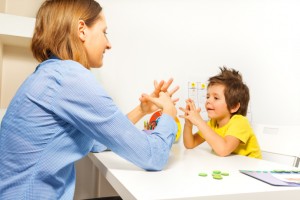
Your child’s physical therapist will do a few exercises to determine the goals of therapy sessions in the future.
We’ve already discussed how to prepare for an occupational therapy visit, but what if your child needs physical therapy?
Physical therapy is an aide for children who have difficulty with balance and movement. Making sure that children move parts of their bodies in the correct way can be essential for avoiding surgery in the future. Here is our guide for preparing for your child’s first physical therapy visit.
Before Your Physical Therapy Visit
There are a few things you can prepare ahead of time to make your first physical therapy appointment go smoother. Consider preparing these three things before your first visit:
- A list of questions: This is your chance to ask those questions you’ve been itching to get answers to. Your physical therapist is there to help you and your child, so don’t feel shy about asking questions!
- A list of symptoms: You’ll have to ask your child about this one. Ask if your child has any pain with certain activities or movements, such as sitting, standing, and walking. Ask if your child notices if these symptoms are worse at certain times of day or if they feel worse or better after resting.
- Your child’s medical history: If your child is on certain medications or has had a recent injury, then it’s best for your physical therapist to know about it. This will help the therapist to structure the appointments in a positive way that is helpful for your child.
During Your Physical Therapy Visit
During your first physical therapy visit, your therapist will ask questions about your child’s health and mobility. Then she will ask your child to perform a few activities while performing an examination. Your therapist will likely examine your child for three main activities:
- Gait: Your therapist will ask your child to walk, examining the way they walk, or their “gait”.
- Functional activities: These are activities that require your child to reposition their body, such as standing up from a lying position or standing from a sitting position.
- Body mechanics: Your therapist will be looking for how your child uses their body for certain physical activities, such as lifting or bending.
It’s a good idea to take notes in a notebook or your phone. You’ll work with your child’s physical therapist to determine goals and daily activities for achieving those goals. And don’t forget to ask your questions! This is a time for working with your child’s therapist to help your child achieve optimal comfort and mobility.
The Connections Therapy Center
The Connections Therapy Center serves families of children and adolescents with disabilities and special needs. We are a team of experts in the fields of pediatric speech, occupational therapy, speech-language pathology, and behavioral sciences. As a team, we offer intensive hands-on therapy for children and adolescents, as well as informative and useful resources for families. If you are interested in learning more about what we can do to help your family, visit us online or give us a call at (202) 561-1110 (Washington, D.C. office) or (301) 577-4333 (Lanham office). Want to get more information on how to help your child thrive? Follow us on Facebook, Twitter, LinkedIn, Google+, and Pinterest.
